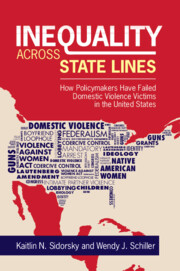 Inequality across State Lines
Inequality across State Lines Book contents
- Inequality across State Lines
- Inequality across State Lines
- Copyright page
- Dedication
- Contents
- Figures
- Tables
- Acknowledgments
- Abbreviations
- 1 Domestic Violence and Gender Inequality
- 2 Federal Action on Domestic Violence
- 3 Policymaking in the States
- 4 Explaining and Predicting the Adoption of State Domestic Violence Gun Laws
- 5 The View from the Courtroom
- 6 The Costs of Inequality in Domestic Violence Policies
- 7 Pathways for Improving Human Security for Women
- Appendices
- References
- Index
6 - The Costs of Inequality in Domestic Violence Policies
Published online by Cambridge University Press: 23 February 2023
- Inequality across State Lines
- Inequality across State Lines
- Copyright page
- Dedication
- Contents
- Figures
- Tables
- Acknowledgments
- Abbreviations
- 1 Domestic Violence and Gender Inequality
- 2 Federal Action on Domestic Violence
- 3 Policymaking in the States
- 4 Explaining and Predicting the Adoption of State Domestic Violence Gun Laws
- 5 The View from the Courtroom
- 6 The Costs of Inequality in Domestic Violence Policies
- 7 Pathways for Improving Human Security for Women
- Appendices
- References
- Index
Summary
In Chapter 6, we consider the personal and political costs of varying domestic violence policies in the United States and we describe the challenges women face for civic participation due to being victims of domestic violence. There is ample evidence that domestic violence can be a barrier to voting and political participation for women, particularly women of color. We also discuss disparities in different communities based on race, ethnicity, and immigration status in terms of the investigation and prosecution of domestic violence crimes and the way domestic violence laws have used criminalization as an answer to domestic violence especially in communities of color. Women of color are much more likely to be accused of domestic violence instead of being seen as victims of it. Those victims who are treated as offenders must live with a conviction on their record, and in most states have their most fundamental right to vote removed while they serve their sentence or are on probation. In the last part of this chapter, we delve more deeply into the current system in place to protect women in light of public health crises such as the COVID-19 pandemic.
Keywords
- Type
- Chapter
- Information
- Inequality across State LinesHow Policymakers Have Failed Domestic Violence Victims in the United States, pp. 150 - 172Publisher: Cambridge University PressPrint publication year: 2023
